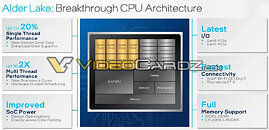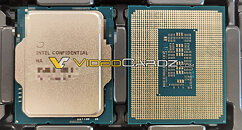Monday, March 22nd 2021

Intel 12th Generation Alder Lake Platform Reportedly Brings 20% Single-Threaded Performance Uplift
Intel only just announced their 11th generation Rocket Lake-S desktop processors last week but we are already receiving information about the next generation Alder Lake-S platform which will finally make the jump to 10 nm. Intel slides for the upcoming family of processors have been leaked and they reveal some interesting information including a claimed 20% single-threaded performance increases from the new Golden Cove core design and 10 nm SuperFin node. The processors will feature Intel Hybrid Technology with a mix of small low-performance cores and large high-performance cores with a maximum of eight each for sixteen total cores. The processors will also include the latest connectivity with both PCIe 4.0 and PCIe 5.0 support along with DDR4 and DDR5 4800 MHz compatibility.
Intel will also be launching a new socket type called LGA1700 with a new package size which will render existing cooling solutions for LGA115X and LGA1200 sockets incompatible. The processors will also come with the launch of a new 600 Series chipset with PCIe 3.0 and PCIe 4.0 support along with the usual complement of USB, SATA, and networking. The entry-level 600-series motherboards will only support DDR4 memory at up to 3200 MHz while high-end Z690 motherboards will include DDR5 support. Intel has confirmed that they intend to launch Alder Lake later this year but it is yet to be known if they are referring to the desktop or mobile series.
Source:
VideoCardz
Intel will also be launching a new socket type called LGA1700 with a new package size which will render existing cooling solutions for LGA115X and LGA1200 sockets incompatible. The processors will also come with the launch of a new 600 Series chipset with PCIe 3.0 and PCIe 4.0 support along with the usual complement of USB, SATA, and networking. The entry-level 600-series motherboards will only support DDR4 memory at up to 3200 MHz while high-end Z690 motherboards will include DDR5 support. Intel has confirmed that they intend to launch Alder Lake later this year but it is yet to be known if they are referring to the desktop or mobile series.



108 Comments on Intel 12th Generation Alder Lake Platform Reportedly Brings 20% Single-Threaded Performance Uplift
A true tigerlake 8 core, like what was promised, on 10nm is nowhere to be found.
You see this in terrible movies, where the pace never slows down to let you think about what just happened, and in shops selling ripoff goods, jam packed with everything on the planet.
Just like Rocket Lake did by 18%? :D :D :D
[SIZE=4][URL='https://www.tomshardware.com/news/intel-rocket-lake-vs-core-i9-10900k-benchmarks']"Rocket Lake Flaunts Up To 18% Higher Single-Core Performance Than Core i9-10900K"[/URL][/SIZE]
Eh lol. Very nice. Bulldozer vibes. The only difference is RL doesn't even have more cores. :DAVX-512 isn't just AVX2 with twice the vector width, it also adds a lot of more operations, allowing for some algorithms to scale beyond just 2x, kind of comparable to FMA.
When heavy applications finally starts to embrace AVX-512, you don't want to go back.
For example if SMT didn’t improve IPC, why would AMD or intel implement such features? If adding more cores wouldn’t improve IPC, why would AMD or intel implement such things? Of course they don’t always improve IPC for all software, but the same is true for most processor improvements.
IPC is instructions per clock of a single core, it's an underlying constant given by the architecture, and is totally independent of core count, SMT, etc. We use single threaded benchmarks to approximate the IPC, using a wide selection of CPU-bound workloads, to eliminate application bias. IPC is not application specific, and it has never equated single core performance, despite being one of the main factors to dictate single core performance.There are so many misconceptions here, where to begin?
SMT is a technique to utilize idle resources in a core, mostly caused by cache misses etc. Regardless if you have 1 thread or 8 threads per core, the total performance of that core will never exceed a single thread that is fully saturating the core. SMT have no impact on IPC.
There are many improvements that has nothing to do with IPC that still yields performance improvements. Clock speeds is the obvious one, core count, and of course more advanced instructions. Additionally you have external improvements like memory and IO, which doesn't affect IPC, but certainly can affect certain bottlenecked benchmarks.
It is instructions per cycle of a single processor.
It is always software dependant, as it is different for all software you run. There is no ”global average IPC” or ”IPC without application bias”, as it is impossible to gather a biasless set of software to use to measure IPC.
Peak IPC is also quite worthless as a measuring stick, though very simple to calculate.
IPC is best measured single core, but its not invalid to test it in a multi threaded environment as well... which everyone does
Same principle as a company always running a few months behind on Windows and Office patches in case they break something.
Well done Intel, in only 5 short years you have gone from being 18 months ahead of the competition to being 18 months behind the competition.
Intel's Zen3 answer should arrive about the same time as Zen4 :DWikipedia. It's such a mess now that you need multi-page tables per branding "generation".
en.wikipedia.org/wiki/Intel_Core
Scroll down and you get to this, which I've doctored:
The thing that really screwed the pooch was when Intel switched to Cove uArch with 10nm but couldn't transition its whole product stack. In a genius move of PR spin to confuse the shit out of everyone and sell previous gen products as new, they continued to name everything "Lake" so that they could continue to sell their old 2015 Skylake uArch derivatives as "new" product in 2020 and hope that reviewers and consumers alike were thinking they were getting something much better than 2015's Skylake.
No, Intel have made just four performance uArches (maybe 3.5 considering how much of the *Bridge uArch was recycled for Skylake, and hence why Skylake's numerous security vulnerabilities go back to Sandy Bridge) in the last 20 years. The *Cove uArch is the step forwards that Intel was hoping to make in 2019, delayed until 2022 because of 10nm failure.Should be a non-issue for any premium coolers as most brands offer free or optional mounting kits for new socket types as they come out.
The basic coldplate of your existing cooler will still be a cooled, flat surface that mates with an IHS, it's not going to be obsolete all of a sudden.
Other than power consumption concerns (that are only halfway related to lower IPC and need for higher clocks) it is actually pretty amazing that Skylake derivatives can be as competitive as they are.You mean the 4 you wrote on the picture? First, that is 15 years - Merom was released in 2006. And it was largely an iteration of earlier Banias (2003)/Dothan/Yonah but that is a bit different story.
Four is not that few. In the same time frame AMD has had K8 (since 2003), K10 (released in 2007 and in many ways an iteration of K8), Bulldozer and Zen.
Only Intel releases a processor that's slower than the one its suppose to replace. :D
You're right about 15 years, I thought Pentium 4 died off whilst I was still an undergraduate but apparently it drooled along in a catatonic state for years whilst AMD held the limelight. I'm not trying to make this an Intel vs AMD flamewar, microarchitectures take a long time to develop and manufacture, but Rocket Lake with Cypress Cove uArch is the first significant uArch change since Sandy Bridge a decade ago. Skylake was a significant enough iteration of the previous Sandy Bridge derivatives to call it a new uArch but at the same time it re-used so much of the existing uArch that it is hard to call truly new, and at 7 years old when the Spec-Ex vulnerabilities went mainstream, it became very apparent that Skylake was not a new architecture but an evolved Sandy Bridge.
I prefer to talk about major vs. minor architectural changes, and the sequence for Intel after Core would be:
Core -> Nehalem -> Sandy Bridge -> Haswell -> Skylake -> Sunny Cove -> Golden Cove (upcoming)
All of these have offered major improvements. Even the often overlooked Haswell was a good improvement over Sandy Bridge, especially in heavier applications. In dense math, even single ints and floats, it scales better than the IPC (which is an average) would lead you to expect. In single algorithms, it's not uncommon to see performance >60-80% faster in Skylake vs. Sandy Bridge, and that's without any AVX or any special instructions.
And don't forget that sometimes an architecture lies the groundwork, before it becomes more useful and refined later. E.g. AVX(1) introduced in Sandy Bridge wasn't that useful or performant at all, then Haswell extended this and offered massive improvements.That's a very flawed assumption.
Just because products have the same design flaws, doesn't make them the same. For most of the vulnerabilities found in Intel, very similar problems were found in all other modern microarchitectures, even though the share none of the same designs. (The same can be said when independent web browsers or SSL implementations have the "same" bugs without sharing code.)
What they do share however, is assumptions. When engineers are building comparable products using the same assumptions, they are destined to do similar mistakes. Most of the high level research for CPUs are done by academics, and is ultimately used by all the CPU designers. If there are flaws in this research, these flaws can end up in designs for years or decades before someone discovers it. That's why questioning assumptions and critical thinking is crucial, but are seemingly forgotten in the sciences today.
The reason is that from a customer point of view, and 'reasonable expectations', the baseline was an Intel CPU with a level of performance per core - and even an AMD CPU (Athlon etc) with a certain level of performance per core. What happened here is that AMD suddenly could sell 'double the core count' which suggested AMD would also have a much more performant product, which was totally not the case. The arguments to turn that into a case you could win, is by focusing on the differences with the contents of a core that DID perform according to expectations. And AMDs marketing didn't help in that regard. They sold the product based on that higher core count as a unique selling point. Its really about the architecture being a departure from an established norm.
Its also easy to turn the principle around. What if AMD's architecture at the time DID offer twice the performance of an Intel quad core? Nobody in their right mind would have even started this legal fight. But in practice, AMD's eight cores could not move quite as much work as Intel quads, especially in then-commonplace single threaded applications. In hindsight, perhaps it was the right technology, but at the wrong moment in time and/or not optimally designed. Perhaps Zen is the ultimate proof of that, except much more refined.Yep. I still remember the Forum Cop episode well. Eternal student looking for internet. Found it. Makes videos that generate clicks. Yawn
Heck I even feature in it :D
a 4x link to the chipset at 5.0 is AMAZING for the USB ports, sata and so on
Performance is likely slightly better than current tiger lakes in single threaded loads and a bit less performant than 12 core amd chip in multi threaded loads. In the rare case where avx512 is of any actual use, it will be pretty ok.